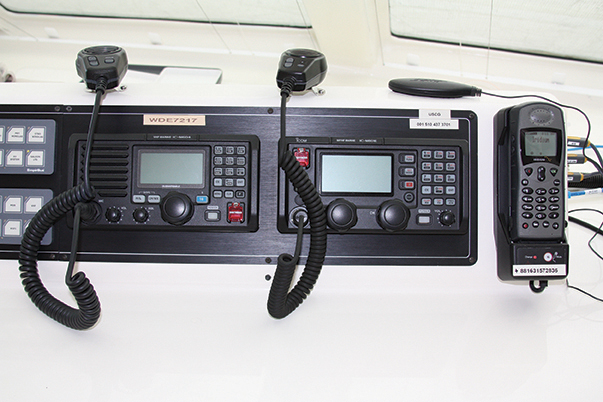For offshore sailors, here are three modern communication solutions for three different budgets (published February 2015)
Skippers and their crews headed offshore should take their onboard communications seriously because the safety and well-being of the crew and your boat may depend upon you being able to get a message out and to receive weather and other information reliably.
As a baseline for all cruising boats headed offshore, the vessel and the crew should be equipped with an EPIRB and individual personal locator beacons. These satellite communications devices are your first line of defense in any Mayday situation since your signal will alert Coast Guards and rescue services around the world that you are in distress and will give them the much needed location of your boat. An EPIRB with a built in GPS will cost under $500. Personal locator beacons will cost between $250 and $450 each.
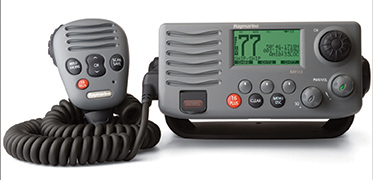
No cruising boat should leave the dock without a modern DSC equipped VHF radio that can be used to speak with fellow cruisers, nearby ships and the harbormasters, marina managers and bridge tenders along your way. Some modern VHF radios also have the Automatic Identification System (AIS) built in so you can easily track ships and other yachts nearby.
It makes a lot of sense to have multiple VHF radios aboard, one with the antenna at the top of the mast that can be mounted below decks at the chart table, and one mounted in the cockpit with its own antenna mounted on a radar pole or the stern rail. It’s also a good idea to have a handheld VHF to take along in the dinghy or, in a worst case scenario, your life raft. Redundancy adds to your safety.
Beyond these essential communications basics, here are three communications solutions for three budget levels: Economy, Business and First Class. Satellite technology has advanced so far and so fast when it comes to devices like EPIRBs and PLBs that they are now within reach of every serious offshore sailor.
ECONOMY CLASS
The simplest and least expensive, and possibly most reliable, way to receive weather information is a small shortwave radio receiver. You will be able to pick up all of the NOAA broadcasts, listen to professional weather routers such as Chris Parker and listen in on the cruising networks on SSB frequencies. A perfectly good shortwave receiver will cost around $100.
To call out from your boat at sea you need to have a VHF that will broadcast about 20 miles. But you need to be able to get a signal out hundreds of miles and for that you will need either an SSB transceiver or a satellite connection. If you are on a real budget, then carrying a SPOT or Delorme In-Reach will be a good solution.
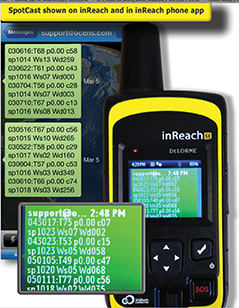
The SPOT technology can be as simple as a one-way SOS or “I’m Okay” message to a more advanced texting and email capability using the new Delorme and the SPOT Connect device. Both use similar technology that has two-way texting with 160-character capability along with a GPS position. Both systems have online tracking that allows your family and friends to go online and see where you are all the time.
As this technology keeps developing, the companies will be leading the way in miniature satellite communications. You can buy the most basic units for around $120 and the more sophisticated ones for up to $450. They need to be registered to each user and you will have to pay a nominal fee to use their services.
Veteran offshore sailors will advise you that you need to have two independent communications systems aboard to provide redundancy and to add flexibility. So, if you are going with these simple satellite devices alone as your primary long-range communications tool, then it is prudent to carry one of each. You will still be under $1,000 and you will be able to send and receive short messages to anyone worldwide.
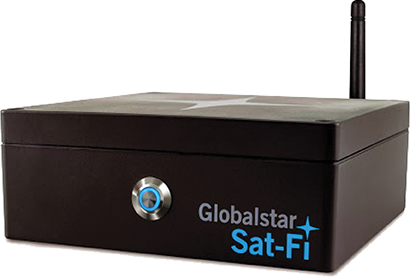 BUSINESS CLASS
BUSINESS CLASS
Traditionally, the primary communications solution for cruisers and offshore sailors has been to install a marine SSB HF radio transceiver. And while this is an expensive way to go, it is a good operating budget solution since the operating costs of an SSB once installed are very low when compared to the cost of running sophisticated satellite communications.
A good SSB and tuner will cost around $4,000. A Pactor P4 Dragon modem that allows you to send and receive email will be around $1,400. And the installation by a professional will probably be an additional $1,000. So, for a well set up, full frequency SSB radio on your boat you will be looking at $6,000 or more. But, there are good discounts out there from specialty vendors such as SeaTech Systems and others that can help whittle down the cost.
With an SSB, you will be able to speak with your cruising friends at a range of up to 2,000 miles. You can tune into the cruising networks that have regular routines in most cruising grounds around the world. These are useful for getting local knowledge as you go and offer a great connection to the cruising community.
The modem allows you to connect to email and weather services. The most economical will be the worldwide SailMail network developed by cruisers Jim and Sue Corenman. A not-for-profit organization, SailMail can handle email, weather, news feeds and more at a cost of only $250 annually.
But HF radios are somewhat finicky to use and are dependent on propagation, solar conditions and other atmospherics. There are times when you simply can’t get a good enough signal to send and receive email or use voice communications.
So, the second choice in this category has long been to add a handheld sat phone with a data link. While you can do this for under $1,000, to make these phones work at sea you need to add an exterior antenna, the data link, a Wi-Fi router and a mounting bracket below decks. Even though handheld sat phones are new technology, there is now something better.
It could well make more sense to leap over the handheld sat phone technology and instead install one of the new satellite based Wi-Fi hot spot systems introduced last year by both Iridium and Globalstar. They are called the Iridium Go! and the Globalstar Sat-Fi. Both systems create a stable link through sophisticated antennas to their respective fleet of satellites and create a hot spot on your boat that allows multiple devices to log on just the way a wireless router at home allows you to connect to the internet through your smartphones, tablets and laptops.
You will need to download the software for your computers and the apps for smart phones and tablets, but that is simple. These systems support voice and data communications but the speeds are fairly low and the amounts of data you can receive and transmit will be limited. By using compression technology you can send larger files but it is not like high speed Internet ashore. Still, it is a big improvement over the handheld sat phone systems.
The difference between Iridium and Globalstar lies mainly in their coverage, or lack of it, and the clarity of the signals. Iridium offers truly worldwide coverage and has proven to be a reliable and well-proven provider. Globalstar does not have worldwide coverage and can suffer from spotty connections at the edges of the coverage zones. Globalstar is expanding and adding satellites but they are well behind Iridium. The Globalstar difference is the clarity of their voice communications and the faster data transmission speeds.
This new hotspot technology moves satellite communications into the forefront of cruising communications. At a cost of about $1,500 for a full setup with an external antenna, which is highly recommended, you can use your smartphone or laptop anywhere in the world that has coverage. But using these systems is expensive. Voice and data links can run from $0.60 to $1.30 per minute or you can sign up for monthly plans that run from $60 for very limited use time to much more. If you want to send email several times a day and make regular phone calls, you could be looking at $500 a month or more.
FIRST CLASS
If you are going for a full professional level of voice and broadband communication, then the professional systems that use the INMARSAT are the way to go—we are talking those domes you see on mega yachts. But, today, KVH, Thrane & Thrane, Intellian and other companies, have downsized their gimbaled antennas to fit inside domes that are small enough to mount on the radar pole of a normal 45-foot cruising boat.
With a gimbaled antenna, the system is able to lock onto a satellite and optimize the upload and download speeds. While you won’t be regularly surfing the Internet, you will find that the voice and data functions are superior to the less expensive versions of satellite communications. Plus, you won’t be dropping the sat link in rough weather the way you do with handheld phones.
Of course, performance comes at a price. At the low end, the Iridium Pilot antenna delivers good voice and data service worldwide in a fairly compact package for about $5,000. KVH’s Tracphone 150 has a 15-inch diameter dome and costs about $6,000. As you move up in size and performance, you quickly get above $10,000 for the dome and system and if you want to knock yourself out, there are top of the line compact systems in the $25,000 category.
On top of the cost of the antenna and phone and data systems, you still have to pay for airtime. The cost to the end user is all over the place because airtime plan discounts are used as loss leaders for dealers selling expensive equipment. So, you will find offers of less than a dollar a minute for an introductory plan. But, after six months, the price could well go over $1.50 a minute. Buying bulk minutes can save you money and there are a number of other plans out there that you will need to study when you purchase the new phone.
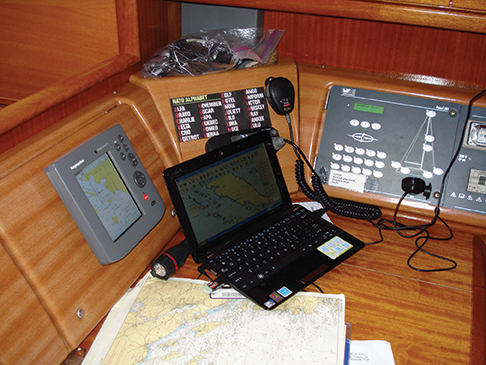 COMMS FOR CRUISERS
COMMS FOR CRUISERS
So what should you have aboard your boat and know how to use before setting out for a blue water passage? As we noted at the outset, you must have an EPIRB and PLBs for the crew. And you must have a good VHF with DSC, and preferably two radios so you can have a spare. Also, because of the low cost and simple utility, carrying a SPOT or Delorme tracker is a no brainer.
After that, you can mix and match systems against your budget so you have two reliable and independent long-range communications systems for touching base with home and friends and to aid in a rescue should you need help out there.
SSB has a proven track record, is inexpensive to use and allows for a lot of cruising community interaction. Using an SSB is both an art and a science but once mastered it is easy and a lot of fun.
The new Iridium Go! and Globastar Sat-Fi is the wave of the future. Although expensive to use, these systems serve our need to stay connected to the Internet and to have email and text readily available. And, to be able to use you own smartphone and tablet with the systems is an added bonus.
















